Are your employees committed to work? Measuring employee engagement will tell you… and help improve productivity and performance. Free advice right here!

.webp)
Measure the ROI of using modern internal communications. Get the template for free without any risk or commitment.
Access Nowhttps://youtu.be/pncciXzUL_8
Employee engagement is the key to productivity, efficiency, and performance within any organization. But not even a quarter (23%) of the world’s employees were effectively engaged at work in 2022. And more than half (51%) were actively looking for a new job.
Gallup, the global analytics and advisory firm has been measuring employee engagement globally since 2009, making them experts in the field. These figures are reflected in their State of the Global Workplace 2023 Report, presented as “the voice of the world’s employees.”
While a 23% rate might appear low, Gallup reveals that this is the highest level of employee engagement they have ever recorded in their global workplace reports. Starting from 2009, employee engagement has risen a little every year. Although engagement declined in 2020 due to the pandemic, it continued its historically positive trend in 2022.
Gallup’s message in the report is that economic growth is slowing and it’s got a lot to do with employee engagement — which is why they measure it constantly.
Gallagher, a global leader in insurance and risk management, also factors employee engagement stats into its 2023 edition of their annual State of the Sector report. Their survey analyzes challenges faced by various organizations and finds that disengaged employees represent their second most important challenge. Nearly a third (30%) of respondents regard it as a significant barrier in their organizations. Adding to the quandary, 22% of organizations lack analytics or measurement tools to measure employee engagement and other issues.
We’re going to discuss employee engagement and why it’s important to measure it. We’ll talk about the role of measurement strategies and suggest seven ways organizations can measure employee engagement.
Quantify the financial benefits of your internal communications
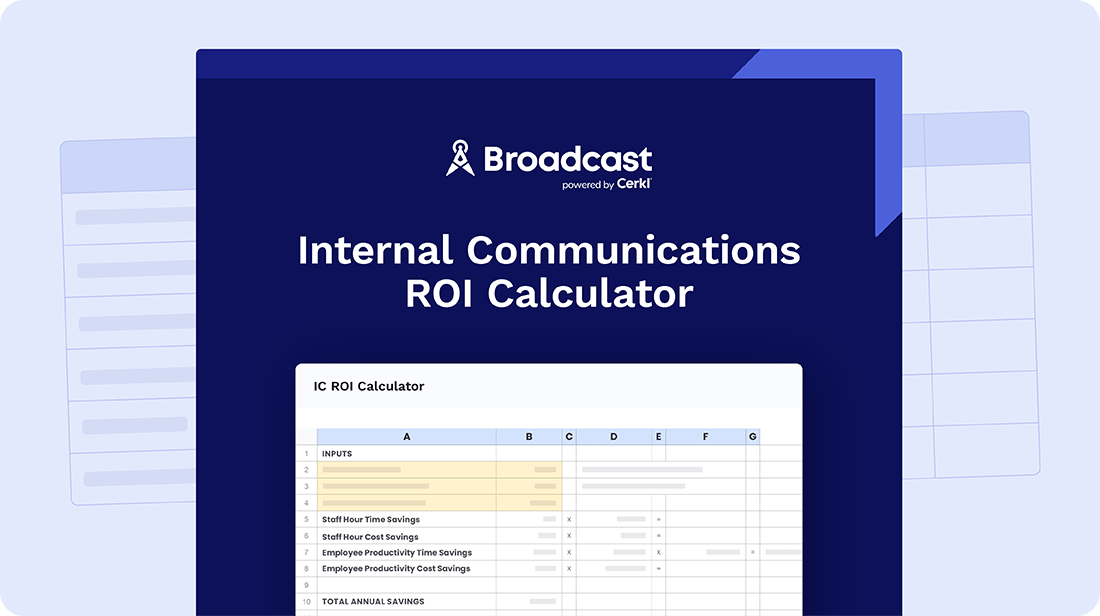
As Gallup’s definitive 2023 report states, employee engagement reflects the involvement and enthusiasm of employees in their work and workplace. But, “Employee engagement doesn’t mean happiness. If you are only measuring employee contentment, you are missing engagement.” Unfortunately, in reality, many organizations are doing just that.
“True engagement means your people are psychologically present to do their work. They understand what to do; they have what they need; and they have a supportive manager and a supportive team. They know why their work matters and they are work-ready.”
Gallup 2023
We’ve learned from the Gallup report that 23% of the world’s employees are engaged at work and thriving. These engaged employees are the ones who feel connected to their organization and teams. They find work rewarding and are proud of what they do. They’re the ones who will always go the extra mile for colleagues and customers. They are also less stressed because of the meaningful connection they have with their organization.
A much larger percentage (59%) of the world’s employees aren’t engaged, but rather “quiet quitting”. They are the clock watchers who do as little as possible. The irony is that while they are only minimally productive, they are more stressed than those who are engaged and more likely to suffer burnout. That’s because they feel disconnected from the organization and their workplace.
One of the questions Gallup asked employees was, “What would you change about your workplace to make it better?” For 85% of those who aren’t engaged, engagement or culture (41%), pay and benefits (28%), and wellbeing (16%) need changing.
Then there are the remaining 18% who are actively disengaged or “loud quitting”. They are generally regarded as troublemakers — employees who will oppose leaders, undercut company goals and cause harm to the business.
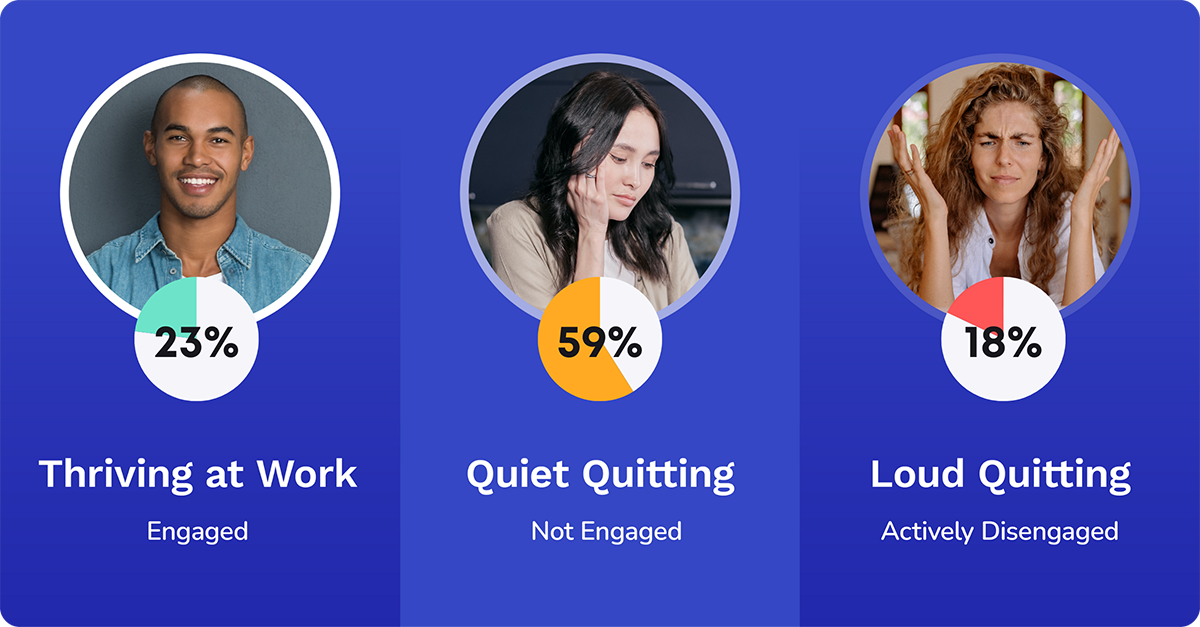
For this report, Gallup measured the financial significance of low employee engagement during 2022. Their estimate is that it cost the global economy a staggering US$8.8 trillion and accounted for 9% of the global GDP.
One of their major takeaways is that the manager is the “linchpin” of employee engagement. With the right management and leadership, employees who are not engaged provide the greatest opportunity for change. These employees “are ready to be inspired and motivated.” But a caveat is that managers are employees too, and many of them are also lacking in engagement.
Measurement strategies play a crucial role in assessing and quantifying the success, impact, and efficiency of various processes and activities within an organization. They provide valuable insights for informed decision-making and continuous improvement. They also help organizations gauge performance, identify areas for optimization, and align efforts with strategic objectives.
Let’s look at how Gallagher and Gallup adopt measurement strategies.
Gallagher’s State of the Sector 2022/23 report assesses how organizations measure the impact of internal communication messages. Their 2022/23 survey included the full range of organizations from enterprises with more than 10,000 employees to small businesses with less than 500 employees.
They found that larger organizations are more focused on prioritizing methods to measure employee engagement and assess the effectiveness of internal communications. It stands to reason. They have more capacity, bigger budgets, and larger teams. However, Gallagher found that all organizations consistently assess the reach of communication. This relates to the effectiveness of getting the message across to employees as well as employee understanding. But overall, the focus isn’t on employee satisfaction or engagement or the business outcome.
They asked survey participants how often they follow certain elements of internal communications. The results (shown below) indicate the percentage of those who said “systematically” or “sometimes”.
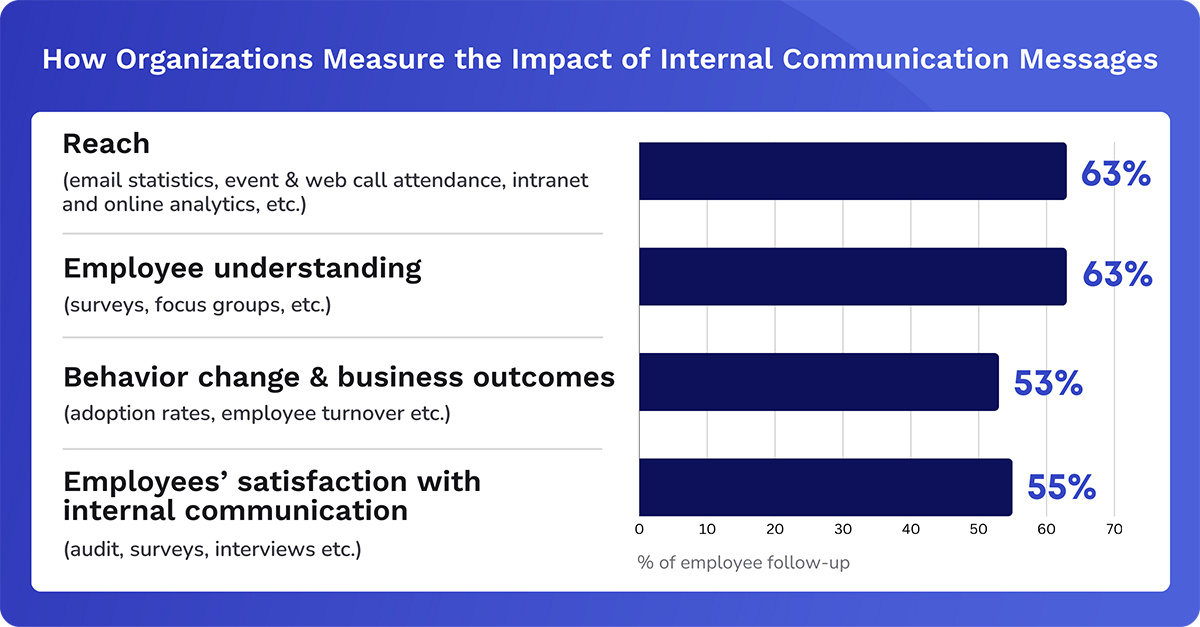
Ultimately, Gallagher’s approach aligns with the importance of measuring employee engagement. But Amanda Sheps considers whether they are measuring what matters. She says that while 63% of organizations regularly measure reach, “knowing employees have simply received a message isn’t enough.” It’s also important to assess when and how employees act on messages.
Another statistic Gallagher quotes is that 52% say the reason for collecting and measuring data is to prove a return on investment (ROI) to leaders. Therefore, says Sheps, “who is communication for?”
“So, we don’t have time to measure, but poor measurement is holding us back. It seems like a vicious cycle, but it doesn’t have to be this way. When it comes to measuring the value of internal communication, a quick and dirty approach is better than none. Imperfect measurement is still a starting point, and the best time to start is now.”
Amanda Sheps, Gallagher
Gallup uses a proprietary formula to measure employee engagement. Founded on extensive research, it relates to a range of workplace outcomes. In essence, it entails asking random employees to respond to certain statements, for example:
Then answers are ranked according to response - strongly agree, strongly disagree, and so on — to determine Gallup’s global indicators.
For its 10th Meta-Analysis, Gallup measured employee engagement in high-engagement companies vs those with low engagement. They found significant differences. For example,
Their message is that the relationship between engaged employees and performance at different levels is substantial. However, it is also “highly generalizable” across organizations because the correlations remained consistent across diverse organizations.
The closest, well-established department that leadership can compare employee communications to is marketing. Marketing measures and builds the customer experience. So, why not use similar employee engagement metrics to measure employee engagement?
While there are tactical and platform similarities, the glaring differences in these formulas are why you should avoid non-click marketing key point indicators (KPIs). Advertisement dollars and target audience value are just a couple of variables. Click metrics make sense in theory. Advertising may send email campaigns while marketing sends corporate newsletters. But this doesn’t prove that your employees are engaged. You’ve just reached them.
Metrics like clicks, channels, and content that you can deliver are more internal communications measurements than employee engagement metrics. They’re practically synonymous with the C-suite, but “communications” and “engagement” are entirely different.
Ultimately, the process we use to measure employee engagement accurately isn’t easy. How can you consistently measure if your employees are excited to come to work? You can’t – there are too many variables that would skew any pulse survey. On some Mondays, employees want nothing to do with work for no reason other than feeling like a two-day break isn’t enough.
So, how do we begin to separate the phrases “employee engagement” and “internal communications measurement” a bit more? It all comes down to expanding your measurements past click rates and reframing how to present your stats.
Aligning organization objectives involves clearly communicating the company's mission and goals, linking individual roles to broader objectives, and fostering a workplace culture that emphasizes purpose and recognition. Ultimately, you want to ensure that employees understand and are motivated by the organization's overall vision.
Quantify the financial benefits of your internal communications

There are certain well-established methods that you can use to measure employee engagement. But there are other strategies you can use too. Here are seven of the best.
The employee net promoter score (eNPS) was developed to get to the root of how employees feel about their company. The way it is done is to ask, for example, “On a scale of 0-10, how likely are you to recommend our organization to your family or friends?” You then sort the results into three different employee categories:
This is a quick, clear way to get a pulse on employee loyalty. Plus, gathering longitudinal data without a data scientist to stand it up is a big bonus. It’s essentially the same approach as the one that Gallup uses, except they have six categories. But the three above fit Gallup’s three categories: quiet quitting, loud quitting, and thriving.
To calculate and interpret eNPS, organizations typically subtract the percentage of detractors from the percentage of promoters. This provides a net score that reflects overall employee satisfaction and advocacy. Passives are generally considered to be neutral, so aren’t included in the calculation.
This strategy involves actively listening to employees, sharing experiences or interests, and building rapport to strengthen relationships.
Strategies include conducting regular one-on-one check-ins to understand individual goals and challenges. You can also implement 360-degree feedback mechanisms to gather insights from peers and supervisors and utilize employee surveys. The surveys should specifically address factors that influence individual job satisfaction and performance.
To obtain valuable personal insights, select a diverse set of employees to share their perspectives and experiences. Then facilitate open discussions on organizational culture, challenges, and successes. These focus groups can provide team leaders with in-depth qualitative insights that complement quantitative data, thus providing a more comprehensive understanding of how engaged employees are.
The best way to extract employee feedback is to implement regular surveys and encourage open communication channels. Be sure to actively listen to employees' concerns and suggestions. The idea is to foster an environment where feedback is not only collected but also utilized for continuous improvement.
Employee retention or the employee turnover rate (ETR) is a bit more of an HR-specific insight. But there are definitely pros to tracking the ETR or employee retention rate for your comms team. Attaching retention numbers to your year in review to show an increase or decrease in turnover is also a great way to show your department’s efforts as they connect to the business bottom-line.
An analysis involves examining the reasons behind turnover and identifying patterns or trends. Then you can use the data to develop targeted strategies for talent retention and overall workforce satisfaction.
Proven strategies include implementing mentorship programs, offering professional development opportunities, and recognizing and rewarding employee contributions. Ultimately, management needs to foster a positive work culture that aligns with employees' values and career aspirations.
To make the connection between productivity and engagement it’s essential to recognize that engaged employees are more productive than those who are disengaged. The solution is to foster engagement through clear communication, meaningful work, recognition, and development opportunities. Ultimately, it is these factors that contribute to a positive and motivating work environment, thus enhancing overall productivity.
Employee productivity metrics include quantitative measures like output volume, project completion rates, and sales figures. Qualitative indicators include task accuracy, time management, and collaboration efficiency. All of these play a crucial role in evaluating overall productivity. Additionally, KPIs aligned with specific job roles and organizational objectives provide valuable insights into individual and team contributions.
Absenteeism can be a strong indicator of employee disengagement. While many employees miss work because they are ill or because of other genuine reasons, absenteeism may suggest a lack of motivation or satisfaction. What happens is that employees choose to disengage by literally opting out of the workplace physically or mentally.
In 2022, the U.S. Bureau of Labor Statistics documented a 3.6% national absenteeism rate, 2.6% of which was attributed to injury and illness. The rest were regarded as “other reasons.” However, according to the Academy to Innovate HR (AIHR), as a rule of thumb, a 1.5% absence rate is regarded as “a healthy rate.”
The best way to address employee absenteeism is to consistently track absenteeism attendance records by implementing an absenteeism tracking system. It’s important to address patterns or individual cases promptly through open communication. It’s also important for HR to understand underlying issues. Equally, it’s vital to offer support or adjustments that may be needed to improve overall engagement and well-being.
Strategies for reducing absenteeism include promoting a healthy work-life balance, providing flexible scheduling options, and addressing workplace stressors. Consider offering wellness programs and creating a supportive and inclusive work environment that encourages employees to be present and engaged at work.
Exit surveys are a feedback mechanism organizations can conduct when employees leave. They help to gain insights into employee experiences, their reasons for leaving, and suggestions for organizational improvement. All in all, they provide valuable information for learning and enhancing strategies to retain employees and minimize ETR.
Team leaders can leverage exit surveys by asking specific questions when employees decide to leave. Focus on employee experiences, their reasons for leaving, and any suggestions they may have for improvement. Analyzing feedback can provide valuable insights that can lead to organizational changes, enhance retention strategies, and address potential issues within the workplace.
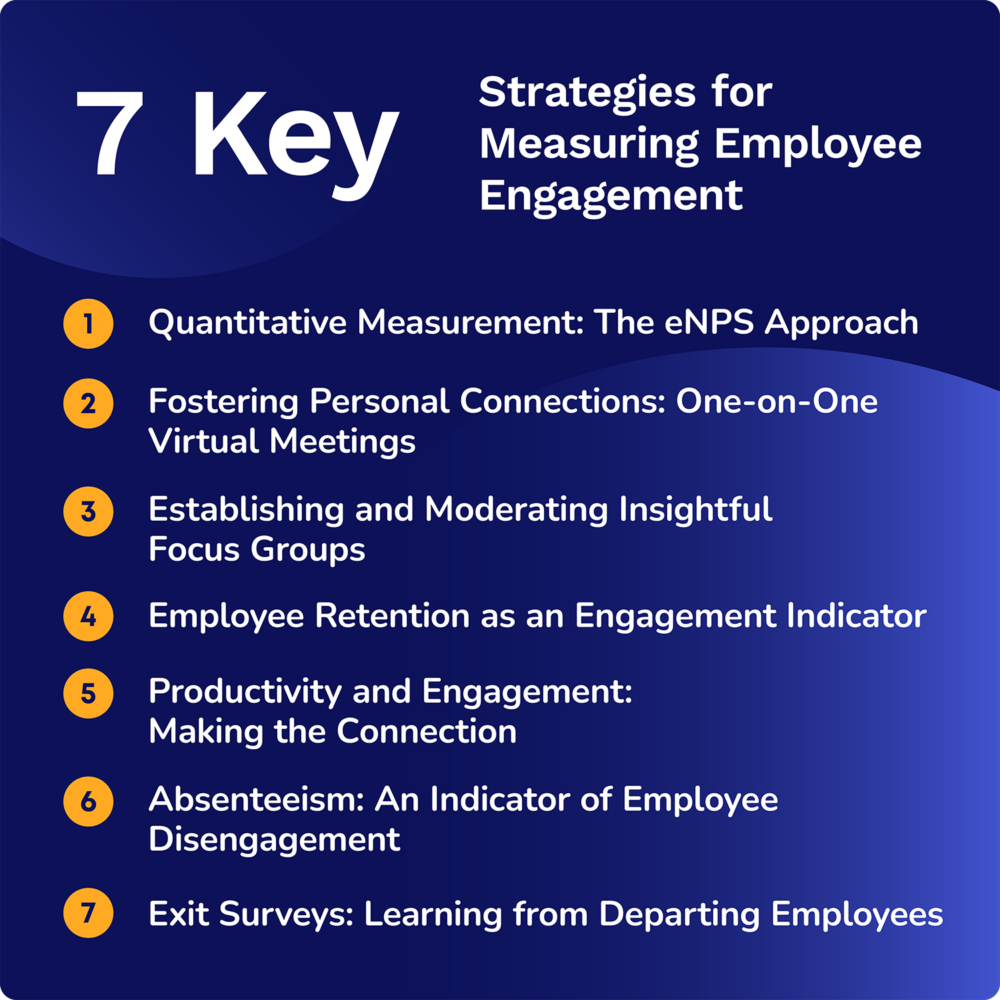
Whichever strategies you choose to measure employee engagement, you can synthesize the data you collect by identifying patterns and trends. Then take action by implementing targeted strategies for improvements based on insights gained. Just be sure to foster informed decision-making and positive organizational change.
The next step is to compile and analyze engagement data by aggregating information from employee surveys, feedback platforms, and performance metrics. This will provide a comprehensive understanding of employee sentiment and areas for improvement.
Finally, you can implement strategic initiatives for improvement by aligning actionable plans with identified areas for enhancement. You will also need to foster a positive workplace culture and address specific factors that contribute to overall organizational success.
Surveys are a great way to get real talk from the horse’s mouth. The problem is that many employees have survey burnout. It’s not surprising since there’s a survey for every department’s tactics and a new form to fill out every other day. To avoid survey burnout, rid the form of ambiguity, stay consistent, and consider aligning surveys with different departments. By combining your resources and taking the reins on the survey send pipeline, cutting down on survey requests makes employees more likely to respond.
There are, of course, lots of different types of surveys including employee communication surveys and employee engagement surveys that focus specifically on engagement. It’s important to ensure these are accessible to every employee all the time. Kathy in Finance might want to squeeze it in on her lunch break, but Trent in Marketing wants to wrap up his day with it. Instead of letting surveys get buried in their inboxes, plaster them on every channel you’ve got. With Cerkl Broadcast, they’ll be able to choose which channel to access surveys from.
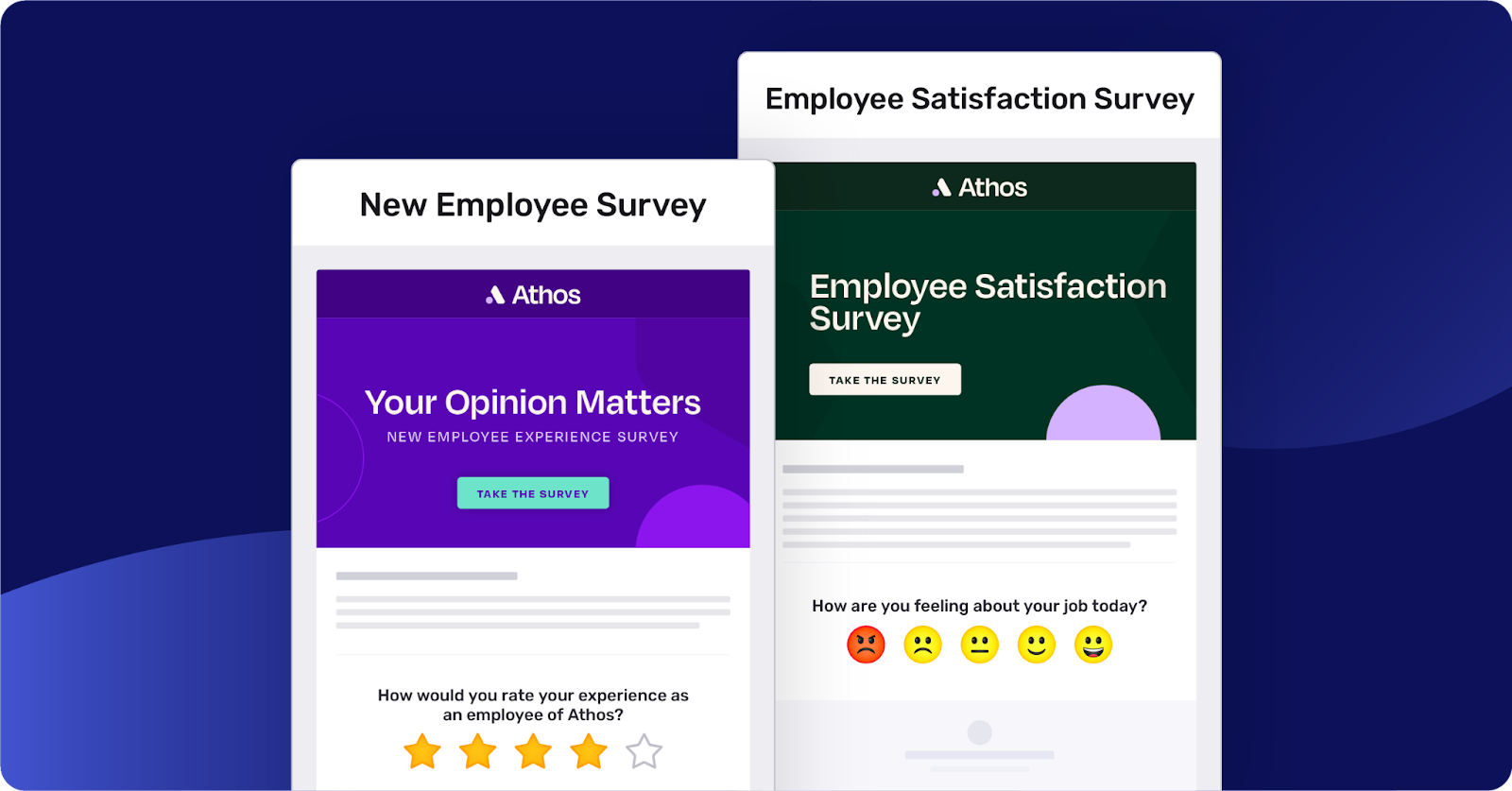
While a few non-click metrics can beef up your internal comms insights, ultimately, none of them measure employee engagement. Things like line manager relationships, equal opportunities, and the fulfillment and how an employee feels from a certain position are the immeasurable measurements that make up employee engagement.
Return on Investment (ROI) is another hot conference topic where the formula is rarely mentioned. The engagement specialists at Cerkl put together an ROI calculator sheet to help internal communications departments map out the potential opportunity. This way they can begin to connect a monetary value to report back on or to get initiatives passed.
Employee engagement is an overused buzzword that embodies a lot but says very little. Suppose we can reframe our employee engagement metrics as reach or employee communications metrics. Then, we can start using KPIs that show departmental value. In that case, we can be closer to creating a better outsider understanding of employee communications priorities and functions.
The only way to engage employees is through consistent, meaningful communication. But to be sure employees are engaged, organizations need proven strategies to measure employee engagement.
The good news is that you can improve internal communications with Cerkl Broadcast and use the platform to help measure engagement.
Features Broadcast offers that can be used to measure engagement include newsletters and surveys you can create using customizable templates. Broadcast also offers powerful feedback and analytics tools, as well as an invaluable ROI calculator. Want to know more? We’re ready to share - are you ready to learn?
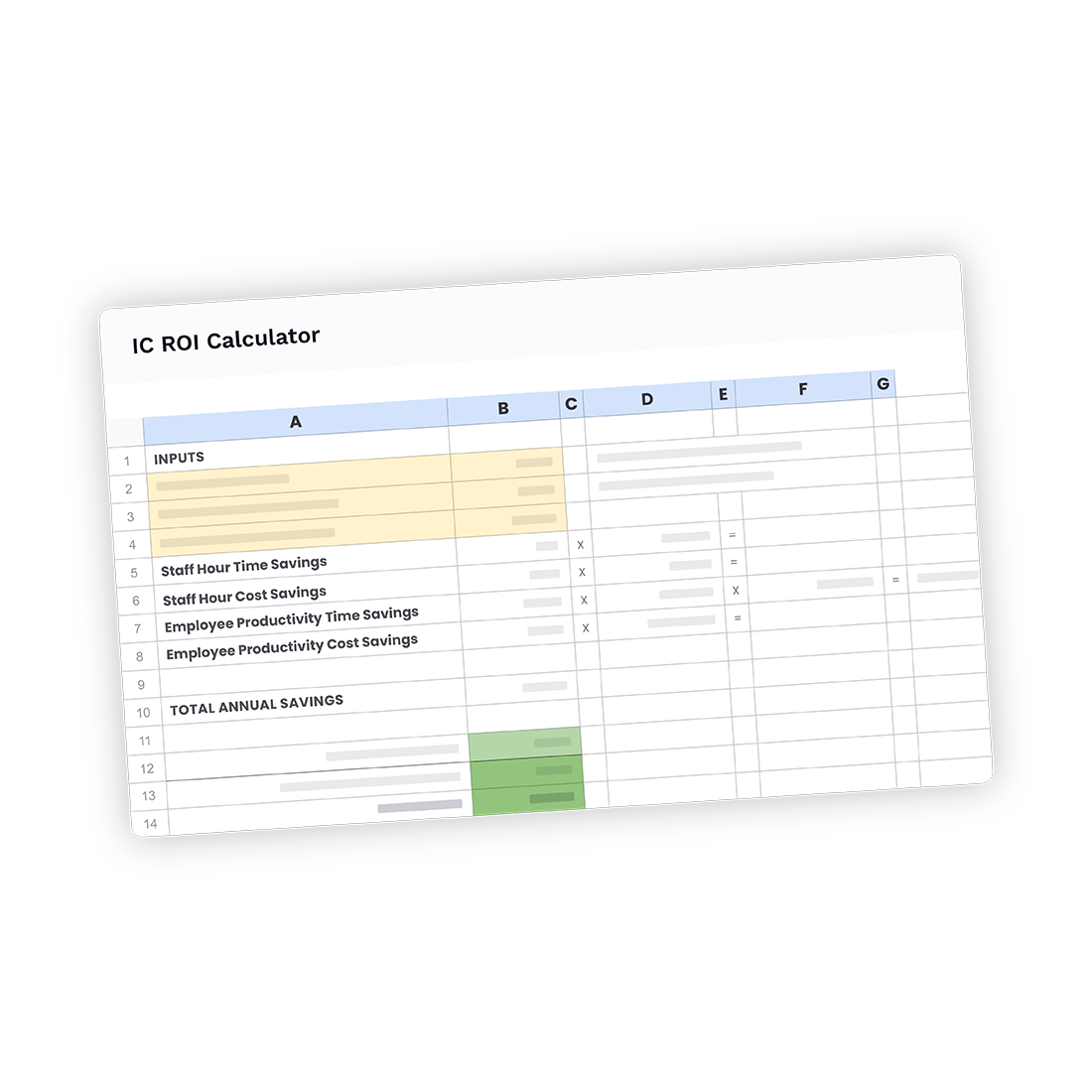
Quantify the financial benefits of your internal communications
What is the best way to measure employee engagement? The best way to measure employee engagement is by using a combination of quantitative surveys and qualitative feedback mechanisms and assessing factors like job satisfaction, alignment with organizational values, and the likelihood of recommending the workplace to others. Regular pulse surveys, one-on-one conversations, and analysis of turnover rates provide a holistic view, enabling organizations to understand and improve employee engagement effectively.
How can we measure employee engagement? We measure employee engagement by evaluating how engaged and satisfied employees are within an organization. We measure employee engagement by assessing factors like job satisfaction, retention vs turnover rates, and participation in company activities. Feedback from employee surveys helps to gauge the overall levels of engagement and commitment.
What is a KPI for employee engagement? A KPI is a metric that we use to measure employee engagement. Typically, a KPI is quantifiable and directly related to the specific goals and outcomes organizations want to achieve.
Why is it difficult to measure employee engagement? Measuring employee engagement is challenging because it involves capturing subjective experiences, emotions, and individual perceptions. This makes it inherently complex to quantify. Additionally, engagement is influenced by various factors, including organizational culture, leadership, and individual roles. This further complicates the development of a standardized measurement approach.

Quantify the financial benefits of your internal communications